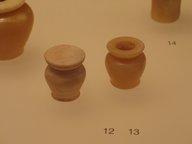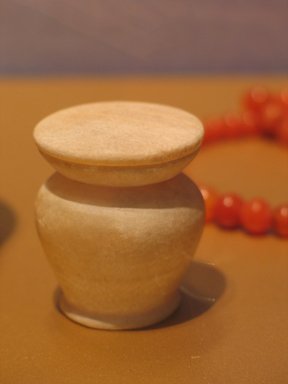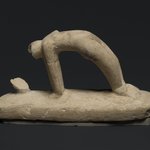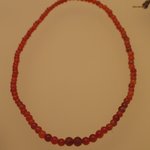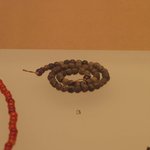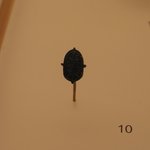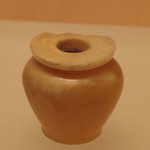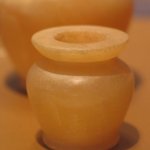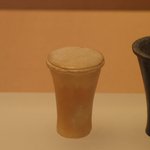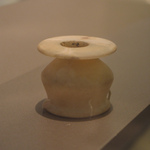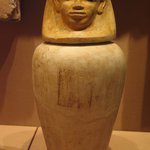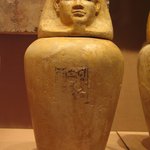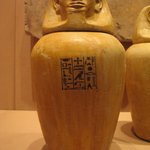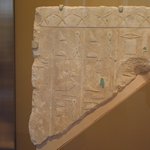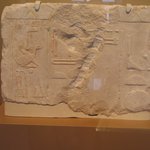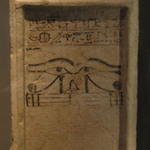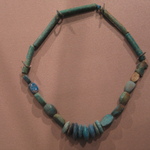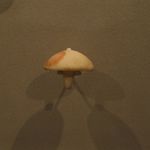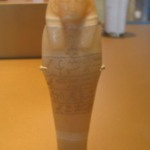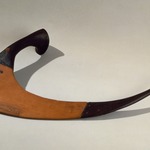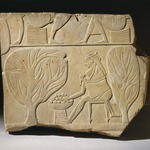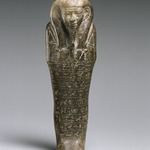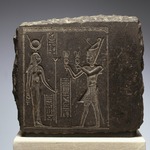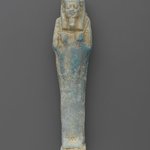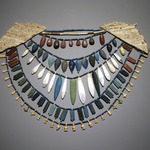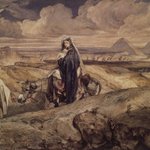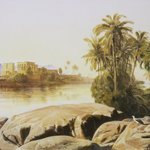Kohl Jar with Cover
Egyptian, Classical, Ancient Near Eastern Art
On View: Funerary Gallery 3, Martha A. and Robert S. Rubin Gallery, 3rd Floor
This image of a mounted king speaking with a shepherd in a village belongs to a manuscript of the Bust?n (Orchard) of Sa'di (died 1283 or 1291), an Iranian poet born in Shiraz and educated in Baghdad. Sa'di's texts and verses are best known for their lyrical reflection upon the human experience. Completed in 1257, the Bust?n falls into the "mirrors for princes" literary genre; such a manuscript would have played an important role in a prince's education, its paintings emphasizing the moral of a given story.
This illustration refers to the tale of a cruel Ghurid king (part of an eleventh-twelfth-century dynasty that ruled parts of Afghanistan and India) who learns an important lesson from a local villager. Lost while hunting one day and separated from his courtly entourage, the king must spend the night alone in the open air. As he prepares to sleep, he spies on a peasant conversing with his son about their cruel king who burdens his mules without feeding them and exploits the wretched and weak. When the king is discovered the next morning by his attendants, one of his boon companions asks how the ruler was treated overnight. Back at court, the king becomes furious as he remembers the words of the peasant and orders the poor man to be brought to him and killed. With little hope of survival, the peasant decides to speak the harsh truth to his king, advising him that a monarch is ultimately judged by his subjects—including the peasant woman at her spinning wheel illustrated in the painting.
The three verses of Persian at the top of the page narrate the moment when the king's courtiers find him after his night alone. The illustration, however, includes references to several parts of the story, suggesting a continuous narrative by encompassing all the characters in one setting.
MEDIUM
Egyptian alabaster
DATES
ca. 1938–1700 B.C.E.
DYNASTY
Dynasty 12 to early Dynasty 13
PERIOD
Middle Kingdom
ACCESSION NUMBER
13.1030a-b
CREDIT LINE
Gift of the Egypt Exploration Fund
CAPTION
Kohl Jar with Cover, ca. 1938–1700 B.C.E. Egyptian alabaster, 1 3/8 x 1 1/4 in. (3.5 x 3.3 cm). Brooklyn Museum, Gift of the Egypt Exploration Fund, 13.1030a-b. Creative Commons-BY (Photo: Brooklyn Museum, CUR.13.1030a-b_mummychamber.jpg)
IMAGE
installation, Egypt Reborn: Mummy Chamber Installation (2011),
CUR.13.1030a-b_mummychamber.jpg. Brooklyn Museum photograph
"CUR" at the beginning of an image file name means that the image was created by a curatorial staff member. These study images may be digital point-and-shoot photographs, when we don\'t yet have high-quality studio photography, or they may be scans of older negatives, slides, or photographic prints, providing historical documentation of the object.
RIGHTS STATEMENT
Creative Commons-BY
You may download and use Brooklyn Museum images of this three-dimensional work in accordance with a
Creative Commons license. Fair use, as understood under the United States Copyright Act, may also apply.
Please include caption information from this page and credit the Brooklyn Museum. If you need a high resolution file, please fill out our online
application form (charges apply).
For further information about copyright, we recommend resources at the
United States Library of Congress,
Cornell University,
Copyright and Cultural Institutions: Guidelines for U.S. Libraries, Archives, and Museums, and
Copyright Watch.
For more information about the Museum's rights project, including how rights types are assigned, please see our
blog posts on copyright.
If you have any information regarding this work and rights to it, please contact
copyright@brooklynmuseum.org.
RECORD COMPLETENESS
Not every record you will find here is complete. More information is available for some works than for others, and some entries have been updated more recently. Records are frequently reviewed and revised, and
we welcome any additional information you might have.

